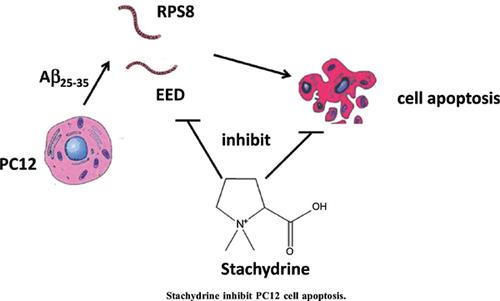Letters in Drug Design & Discovery ( IF 1.2 ) Pub Date : 2021-05-01 , DOI: 10.2174/1570180817999201110115007 Huan Fu 1 , Mei Liu 1 , Jinxiu Yan 1 , Na Zhao 1 , Liangchao Qu 1

|
Background: Abnormal deposition of amyloid beta (Aβ) is considered the primary cause of neurocognitive disorders (NCDs). Inhibiting cytotoxicity is an important aspect of the treatment of NCDs. Stachydrine (STA) has been widely used for gynecological and cardiovascular disorders. However, whether STA has protective functions in PC12 cells treated with Aβ25-35 remains unclear.
Introduction: Traditional Chinese Medicine, stachydrine (STA), is a water-soluble alkaloid of Leonurus heterophyllus, which can inhibit cell apoptosis, suppress tumor growth, maintain homeostasis of myocardial cells, and alleviate endothelial dysfunction. This study will investigate the effect of STA on inhibiting PC12 cell apoptosis induced by Aβ25-35 in an in vitro cell model of neurocognitive disorders.
Methods: The differentially expressed genes (DEGs) in cells treated with STA were analyzed according to the Gene Expression Omnibus (GSE) 85871 data, and the STITCH database was used to identify the target genes of STA. PC12 cells were treated with Aβ25-35 and/or STA, 3-(4,5- dimethylthiazol-2-yl)-2,5-diphenyltetrazolium bromide (MTT) assay was performed and lactate dehydrogenase (LDH) activity was determined. The cell cycle distribution was detected by flow cytometry, and quantitative reverse transcription-polymerase chain reaction (qRT-PCR) or Western blotting were used to detect the expression of genes or proteins.
Results: GSE85871 data showed 37 upregulated and 48 downregulated genes among the DEGs affected by STA. The results from the STITCH database showed that RPS8 and EED were target genes of STA. GSE1297 analysis showed the 13 most significantly upregulated genes. STA might affect the occurrence of NCDs through the interaction of TP53 with EED and RPS8. Finally, Aβ25-35 promoted apoptosis and LDH release of PC-12 cells, arrested the cell cycle in the G2/M phase, and inhibited the expression of the RPS8, EED, Bcl-2 and P53 genes. STA could reverse the effect of Aα25-35.
Conclusion: STA may play an important role in inhibiting apoptosis induced by Aβ25-35 by targeting the RPS8 and EED genes in the NCDs model in vitro.
中文翻译:

水苏碱在神经认知障碍的体外细胞模型中抑制 Aβ 25-35诱导的 PC12 细胞凋亡
背景:β 淀粉样蛋白 (Aβ) 的异常沉积被认为是神经认知障碍 (NCD) 的主要原因。抑制细胞毒性是非传染性疾病治疗的一个重要方面。水苏碱 (STA) 已广泛用于妇科和心血管疾病。然而,STA 在用 Aβ 25-35处理的 PC12 细胞中是否具有保护功能仍不清楚。
简介:中药水苏碱(STA)是益母草的水溶性生物碱,具有抑制细胞凋亡、抑制肿瘤生长、维持心肌细胞稳态、缓解内皮功能障碍等作用。本研究将在神经认知障碍的体外细胞模型中研究 STA 对抑制 Aβ 25-35诱导的 PC12 细胞凋亡的影响。
方法:根据Gene Expression Omnibus(GSE)85871数据分析STA处理细胞的差异表达基因(DEGs),利用STITCH数据库确定STA的靶基因。用 Aβ 25-35和/或 STA处理 PC12 细胞,进行 3-(4,5-二甲基噻唑-2-基)-2,5-二苯基溴化四唑 (MTT) 测定并测定乳酸脱氢酶 (LDH) 活性。流式细胞术检测细胞周期分布,定量逆转录-聚合酶链反应(qRT-PCR)或Western blotting检测基因或蛋白质的表达。
结果:GSE85871数据显示受STA影响的DEGs中有37个上调基因和48个下调基因。STITCH数据库结果显示RPS8和EED是STA的靶基因。GSE1297 分析显示了 13 个最显着上调的基因。STA 可能通过 TP53 与 EED 和 RPS8 的相互作用影响 NCDs 的发生。最后,Aβ 25-35促进 PC-12 细胞凋亡和 LDH 释放,在 G2/M 期阻滞细胞周期,并抑制 RPS8、EED、Bcl-2 和 P53 基因的表达。STA 可以逆转 Aα25-35 的作用。
结论:STA可以起到抑制细胞凋亡Aβ引起了重要作用25-35通过靶向体外非传染性疾病模型RPS8和EED的基因。











































 京公网安备 11010802027423号
京公网安备 11010802027423号